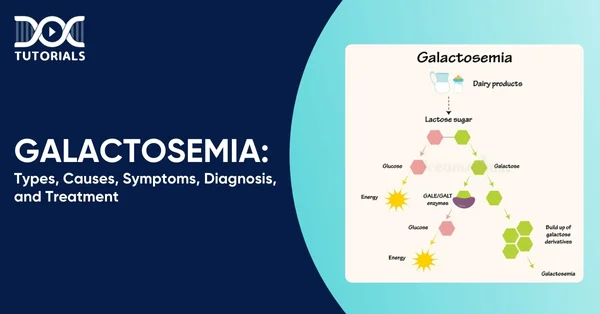Galactosemia | Types, Causes, Symptoms, Diagnosis, and Treatment

Certain infants are born with galactosemia, which is a rare metabolic disorder that hinders their ability to break down galactose properly. Without proper enzyme activity, galactose builds up in the body, potentially leading to a range of health issues. These are particularly involving the liver, brain, and other essential organs.
Early identification is crucial, as untreated galactosemia can lead to severe and potentially life-threatening complications. Understanding the concept of galactosemia is crucial if you’re preparing for the NEET PG exam.
Keep reading this blog to get a comprehensive knowledge of galactosemia.
What is Galactosemia?
Galactosemia is a hereditary metabolic condition in which the body cannot properly process galactose, a type of sugar. This disorder poses particular risks for newborns, as galactose is found in both breast milk and most infant formulas.
Classic galactosemia is the most prevalent form of the condition and is caused by a deficiency of the enzyme galactose-1-phosphate uridyltransferase (GALT). This enzyme plays a key role in converting galactose into glucose.
What are the Different Types of Galactosemia?
Following are the different types of galactosemia:
- Type I (Classic Galactosemia)
It is the most prevalent and the most serious type of the condition. The classic galactosemia is caused by a mutation in the GALT gene. In this mutation, galactose cannot be processed by the body because there is a total deficiency of the enzyme. Thus, galactose accumulates quickly and brings about a number of health complications.
- Type II (Galactokinase Deficiency)
Type II galactosemia is linked to mutations in the GALK1 (galactokinase 1) gene. This gene produces enzymes that support the breakdown of galactose. This form tends to cause fewer complications, with the most notable risk being the development of cataracts.
- Type III (Galactose Epimerase Deficiency)
Mutations in the GALE (UDP-galactose-4-epimerase) gene cause type III galactosemia. This gene also aids in the production of enzymes that help in galactose metabolism. When there is a shortage of these enzymes, then there is a build-up of galactose.
The symptoms can either be mild or severe. More severe ones can undergo problems resembling those presented in classic galactosemia, including cataracts, developmental delays, liver problems, intellectual retardation, and kidney dysfunction.
- Duarte Galactosemia
Duarte galactosemia is also caused by mutations in the GALT gene but represents a milder form of the disorder. While the enzyme activity is reduced, it is not completely lost.
The majority of people with Duarte galactosemia could show partial digestive discomfort with galactose foods but typically do not undergo the same severity of health complications as the classic form. In many cases, dietary restriction is not necessary.
What Causes Galactosemia?
Galactosemia is an inherited disorder, meaning a child must receive a faulty gene from both parents to develop the condition. In babies with galactosemia, the genes responsible for producing enzymes that convert galactose into glucose are defective.
Such enzymes are either dysfunctional or nonexistent. As a result, galactose cannot be broken down efficiently and begins to accumulate in the bloodstream. This leads to serious complications in newborns.
What are the Risk Factors of Galactosemia?
The following are the risk factors of galactosemia:
- Gender: Both males and females are equally likely to be affected by the condition.
- Age: Galactosemia is most often identified during the newborn period through standard screening programmes.
- Family History: The likelihood of developing galactosemia increases when there is a known history of the disorder within the family.
- Geographic Background: The condition is more common among individuals of Northern European ancestry, likely due to inherited genetic patterns.
What are the Symptoms of Galactosemia?
Galactosemia symptoms can differ based on the severity of the enzyme deficiency and the age at which the condition presents. Some of the most common signs include:
- Jaundice: Discoloration of the skin and eyes caused by liver impairment.
- Vomiting: Repetition of vomiting, particularly after feeding.
- Feeding Difficulties: Infants may struggle to receive proper nutrition or show inadequate weight gain.
- Lethargy: A noticeable lack of energy or persistent tiredness.
- Irritability: Babies may appear unusually fussy or unsettled.
- Cataracts: There can be cloudiness on the lens of the eye in certain instances.
- Delayed Development: Children may experience lags in reaching expected developmental milestones.
How to Diagnose Galactosemia?
Early detection plays a vital role in preventing the damaging effects of galactosemia. In several countries, it forms part of the standard newborn screening programme. The typical diagnostic process includes the following steps:
- Newborn Screening
Within the initial days of birth, a bit of blood is taken out of the heel of the infant. This sample undergoes a test to determine elevated levels of galactose.
- Follow-up Tests
If initial results suggest galactosemia, further testing of blood and urine is carried out to assess enzyme function and galactose concentration. Genetic analysis may also be conducted to pinpoint the specific mutation involved.
- Differential Diagnosis
Doctors may explore other possible causes that present with similar symptoms, including various metabolic disorders or infections.
What are the Treatment Options for Galactosemia?
Although there is currently no cure for galactosemia, the condition can be effectively managed with appropriate dietary adjustments. People with galactosemia must eliminate all sources of galactose from their diet.
This includes avoiding milk, dairy products, and some types of legumes. A dietitian can assist in developing a well-balanced eating plan that excludes galactose while still fulfilling nutritional requirements. Alongside dietary restrictions, individuals may also benefit from the following:
- Nutrient Supplementation
Due to the limitations of a galactose-free diet, supplements may be needed to maintain adequate levels of vital nutrients.
- Routine Monitoring
Regular check-ups help one track growth and development, and detect any possible complications early, ensuring timely intervention.
FAQs About Galactosemia
- What are the different signs of galactosemia?
Common signs of galactosemia include jaundice, frequent vomiting, feeding difficulties, low energy levels, increased irritability, cataract formation, and delays in developmental milestones. Prompt medical evaluation is important when these symptoms appear in infants.
- How is galactosemia managed?
Galactosemia is treated by ensuring that no source of galactose is used in the diet, and this means avoiding all dairy products. Infants are typically put on non-cow milk proteins, like soy-based or elemental. Vitamin D supplements and calcium are frequently prescribed to keep bones healthy in order to offset the effects of insufficient dairy.
- Is galactosemia detected at birth?
Galactosemia is a part of the newborn screening programme in many countries. The condition is detected early by testing a heel-prick blood sample after the birth of the child.
- What is the expected lifespan for individuals with galactosemia?
With early diagnosis and a strict galactose-free diet, many people with galactosemia may live a normal and healthy life. Nevertheless, the general life expectancy can be affected by the level of severity of the disorder and other long-term complications.
- What ongoing care might be needed for the long-term effects of galactosemia?
Children who have galactosemia may still develop chronic complications even after maintaining a stringent galactose-free diet. These include delays in speech and language development, difficulties with learning or intellectual challenges, motor skill delays, cataracts, and ovarian insufficiency in females.
Ongoing support, such as therapies and regular monitoring, can help manage these outcomes effectively.
Conclusion
It is essential to get a clear picture of the causes, effects, diagnostic procedure, and available treatment of galactosemia, not only in academic learning but also in clinical practice. As early diagnosis and dietary management are vital in preventing long-term complications, healthcare professionals must recognise the condition promptly, particularly in newborns.
This topic plays a crucial role in managing these conditions and equips NEET PG aspirants with the clinical insight required to make informed decisions. With DocTutorials, you can get a comprehensive NEET PG preparation source through high-yield video lectures, expert-led discussions, and more.
Explore our NEET PG course today and take a confident step towards securing your medical career!
Latest Blogs
-
-

NEET SS Exam 2024: Analysis, Key Dates, Counselling
The NEET SS 2024 exam kicked off on March 29, 2025. Over two days and two slots, candidates across 13…
-

NEET PG Registration 2025: An Essential Guide For Exam Prep
The NEET PG registration, which is conducted online, is a crucial step in the exam process. Filling out the NEET…





